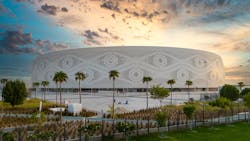Idrica provides water management software for Qatar
The FIFA World Cup in Qatar had a major challenge ahead: the efficient use of water during an event that is expected to be attended by over 1.5 million people, in a country with one of the world’s highest water stress rates. To respond to this issue, Idrica Qatar, through its GoAigua Sewer Twin solution, will be involved in optimizing water resource operations and management to provide greater control and monitoring over critical locations.
The company’s tool integrates, processes, and exploits data from multiple sources, thus centralizing indicator visualization and asset control. The digital solution monitors the areas around seven football stadiums, the teams’ training and accommodation areas, and the so-called fan zones, where 76 sensors and 1,500 field signal meters have been installed.
The platform provides greater control over the network and helps to prevent adverse water situations during the event. It includes alerts based on rainfall forecasts, integrated with Qatar’s meteorological agency. The platform also monitors water levels, water speed, and flow in wells in the sewerage and rainwater networks, and the pressure of the treated water network.
Christian Perez, Idrica's Technical Manager, points out that this initiative started after the 2021 FIFA Arab Cup, "where shortcomings were detected in the monitoring of stadiums, water levels in utility maintenance holes, and in treated water pressures and odors".
Both the Arab Cup and the World Cup are held during the rainy season, when rainfall is very heavy and causes severe flooding.
"Despite being an arid climate," says Perez, "The rainy season is a challenge, because Qatar is not sufficiently prepared to provide a solution to this type of critical events that lead to flooding and cripple the region to a certain extent".
Therefore, in addition to real-time monitoring, the system also features alarms based on rainfall forecasts.
As FIFA states on its website, many stadiums have systems for detecting leaks and measuring water flows, helping administrators with management, optimizing response times, and streamlining water use.
